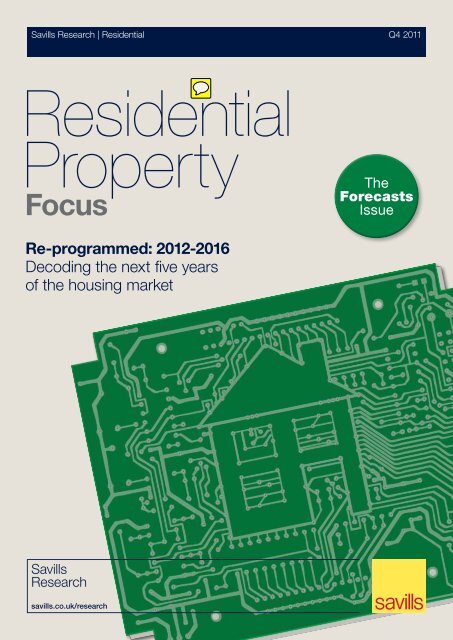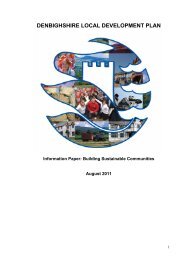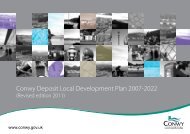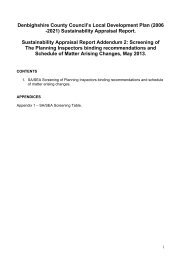HS5-R751 - Denbighshire Local Development Plan
HS5-R751 - Denbighshire Local Development Plan
HS5-R751 - Denbighshire Local Development Plan
You also want an ePaper? Increase the reach of your titles
YUMPU automatically turns print PDFs into web optimized ePapers that Google loves.
Savills Research | Residential Q4 2011ResidentialPropertyFocusTheForecastsIssueRe-programmed: 2012-2016Decoding the next five yearsof the housing marketSavillsResearchsavills.co.uk/research
Residential Property Focus | Q4 2011ForewordWhat next in there-programmedeconomy?Since we made our forecasts last year the worldhas changed, and we are making them this yearviewing a dramatically altered economic outlookOur forecasts for thehousing marketare shaped byforecasts fromOxford Economicsfor economic growth, householdincomes, base rates and all theother variables that go into ourmodel of housing affordability.This host of variables is determinedby their outlook for the globaleconomy. This year, in common withvirtually every other forecaster, theyhave been revising their outlook forgrowth consistently and constantlydownwards. Expectations are now, atbest, for continued lower growth ratherthan the gradual recovery predictedin 2010.So we now find ourselves lookingat a fundamentally altered nationaleconomic backdrop – and also apotentially confusing array of housingmarket indicators saying differentthings. Taken on an annual basis,house price movements in the 12months to September varied accordingto which monitor you looked at.Rightmove said +1.5% while LandRegistry and Hometrack said -2.6%and -3.5% respectively. Our indexfor prime central London propertywas saying +13.6% while our indexof prime regional property showed–2.8%. Clearly, market behaviour hasbeen complex.There are three drivers at work inthe market currently: 1. Overseasequity 2. Wealth created domesticallyand 3. Limited mortgage availability.Prime central London is acting asa safe haven for global wealth so isgrowing. Prime South East marketsand London-centric markets didbenefit from city bonuses and financialsector recovery after March 2009 butare now waning. Elsewhere, there hasbeen essentially no significant recoverysince the markets fell in 2008 andtransactions have been extremely low.So the market has polarised inthree directions: between the equityhaves and have nots, between Northand South and between prime andmainstream. No wonder differentindices are saying different things.Understanding these differences helpsshed light on the market.Asking price indicators reflect theoptimism of vendors rather than theprice at which a property will actuallytransact. This is valuable in revealingthe stickiness of supply that dogs themarket. It shows how turnover is oftenthe first casualty of a falling market assellers withdraw (or let) their propertywhen they can’t achieve a desired price.There is a difference betweentransactions involving a mortgageand those involving equity. Cashtransactions are now a more significantproportion of the market than everbefore. These transactions are notshowing up in every index and aremaking the whole-market samplemeasured by Land Registry verydifferent to what has gone before.Valuation-based indices have arepresentative sample of all stock, notjust the properties that are selling at anyone time. They tend to pick up changeearlier than others which have to waitfor vendor’s expectations to adjustand a transaction to take place. Theseindices outside London have picked upsigns of further falls in property valueand indicate vendors will have to adjusttheir expectations if they want to sell.This forecast issue suggests howmuch these expectations may needto adjust over the next five years indifferent markets. nExecutive summaryThe key findings in this issue■ Most property markets in the UK have not seen therecovery observed in the London-centric markets ofsouthern England and have remained at low levels ofgrowth and/or seen small falls since 2008.■ We expect very low growth in average nominalhouse prices over the next five years. It is inflationthat will continue to strip value from mainstreamproperty over this time.■ In the absence of widespread repossessionsflooding the domestic markets, we see thatturnover will remain the main casualty of thisrecession, with transaction levels staying at theirall-time low level.■ London and southern markets, and particularlyprime markets, are different. They have seen aV-shaped recovery as opposed to the L-shape ofother regions. This is because they are capable ofbeing driven by buyers with large amounts of equityand low reliance on borrowing. The discretionarynature of these purchasers makes these marketsmore volatile however, and buyers withdraw whensentiment fails.■ Prime London is different again as it belongs to adifferent class of world cities. The downside risks inthis market are factors which diminish the creationof global wealth, such as commodity prices andappreciation in the sterling exchange rate. Whileglobal economic turmoil persists and the global richseek a safe-haven store of wealth and a sterlingdenominatedcurrency play, prime central Londonproperty will prosper.Contents04 UK mainstream market06 Market forecasts08 UK prime markets10 Private rented sector12 Housebuilding14 TransactionsYolande BarnesHead of ResidentialResearch020 7409 8899ybarnes@savills.comwww.savills.co.uk/research 03
UK mainstream marketinflation is majorthreat to valueDue to weak economic growth andconstrained access to mortgagefinance, our forecasts predict lowcapital growth prospects for themainstream market over the mid termWords by Lucian CookGraph 1.1Components of Housing Affordability 2010-2016Index (2010 = 100)12011511010510095908580mainstream MARKETSFive-year forecast values 2012-2016Graph source: Oxford Economics, Savills ResearchForecasts 2012 2013 2014 2015 2016UKLondonGraph source: Savills ResearchThis time last year, weforesaw a turbulent timefor mainstream houseprices and anticipatedthat austerity measuresin the economy would start toimpact on household finances andhome buyer confidence.These effects have indeed turnedout to be negative, but not asdamaging to values as we thought.The main casualty of the currentn Real Debt Servicing n Real Annual Disposable Income n Real Annual Basic SpendIncreased basicspend and debtservicing costsDisposable incomesflat in real termsInflationadjusted5-year growthNominal5-yeargrowth-2.0% 0.5% 1.0% 2.0% 4.5% -11.0% 6.0%-0.5% 1.0% 5.0% 6.0% 6.5% 2.0% 19.1%2010 2011 2012 2013 2014 2015 2016housing market downturn has beentransaction levels. Owners are simplynot selling in the current climate and,with interest rates at manageablelevels, are not forced to sell.While these circumstances prevailand repossessed and distressedstock levels remain low, it is difficultto see the mechanisms by whichwidespread price falls will take place.This means the shape of themainstream housing market haschanged rather more than houseprices over the past 12 months.In this article we argue that it isinflation, rather than nominal pricefalls that will erode housing valueover the next few years.More equity, less debtTransaction levels have been farlower than the pre-crunch norm forsome four years now. Proportionatelymore equity and less debt has beenused to buy property. This has ledto relatively stable prices, with littleupward or downward movementacross the country as a whole.In recent decades, average houseprices have outgrown infation byaround 2.5% per annum. Due tothe recent downturn though, therehas been no real (inflation-adjusted)growth so that in real terms, averagemainstream house prices now standat 2003 levels.economic viewExpectations for global economicgrowth now incorporate a‘second slip’ over 2012 thatwasn’t there this time last year.The implications for the UKare that 2012 GDP, which wasexpected at around 2.5%, isnow likely to be closer to 1%,provided Eurozone collapse andits wider economic implicationsare avoided. The resulting levelsof unemployment will suppresshousehold income growth and,in turn, suppress both householdconsumption generally andspending on housing in particular.Positively for the housing market,poor economic growth prospectsserve to depress base rates andhelp prevent mass repossessionsflooding the market.04
Residential Property Focus | Q4 2011This raises the question of whetherausterity measures have created anew era for mainstream house prices,with the trend of inflation-bustinghouse price growth firmly consignedto history.Affordability levelsWith the economic outlook weakeningover the past 12 months andforecasts for the recovery beingpushed out further, the Bank ofEngland is likely to maintain baserates at their historically low level forlonger than expected.Following the announcement ofa further expansion of quantitativeeasing by £75 billion, our economicforecasters do not foresee any baserate increase before Q2 2013 at theearliest. This should have the effectof preserving affordability levels forlonger, but it can no longer be reliedupon to enable a return to real houseprice growth.Our model of house priceaffordability is based on whether,after taking care of basic expenditure,households can afford the mortgagepayments on the purchase of a newhouse. Through 2008 house priceaffordability soared as prices, levelsof borrowing, and interest rates all fell,but we have already seen some of theaffordability cushion built up duringthat period eroded by the rebound inhouse prices during 2009, high levelsof inflation and flat real incomes.Growth constraintA continuation of these factorscombined with base rate risesfurther down the line, are likely toerode affordability further. This is likelyto limit the capacity for price growthat a national level, with the lack ofeconomic growth meaningthe trigger for house price growth isalso pushed back.Taking all of the above into accountour mainstream forecasts have beencut back since this time last year.At a national level, prices are forecastto remain flat. We are predicting totalnominal growth of 6.0% in the averageUK house price over the five yearperiod covered by our forecasts.We expect the picture to varygeographically. Relatively strongfive year price growth in London(19.1%) and the surrounding markets(South East 15.7% and East 14.1%)FIGURE 1.1HOUSING MARKET FORCES 2012-2016 Drivers, implications and consequencesdelayedtrigger forhouse pricegrowthlow capitalgrowthprospectsWeakeconomicgrowthpressureonhouseholdincomesis expected on the back of strongereconomic performance and a lesserreliance on mortgage finance. Bycontrast, northern regions are set tolag, seeing little to no growth (seepage 6).While real house price growth islikely to be put on hold for sometime, it does not necessarily followthat it is consigned to the historyDriversimplicationslowtransactionlevelsconsequenceshighlenders’marginsConstrainedaccess tomortgagefinancebooks forever. At the end of 1995,inflation-adjusted house prices wereat the same level they were 12 yearspreviously. In the following decadethey rose by 140% in real inflationadjustedterms.We now expect a period ofnecessary house price affordabilitycorrection that will push out yieldsand be a draw for investors. nissues ofdepositaffordabilityincreaseddemand forrentalpropertystrongrental growthprospectssavills.com/research 05
House price valuesMARKETFORECASTSPRIME MARKETSFive-year forecast values, 2012-2016Change frompeak to date2012 2013 2014 2015 20165 years to2016Prime Central London 15.6% 3.0% 0.0% 5.0% 6.5% 6.5% 22.7%Prime Regional -16.6% -3.0% 2.5% 4.0% 5.5% 5.5% 15.1%Prime South East -12.5% -2.5% 3.0% 6.5% 6.5% 6.5% 21.3%Prime South West -20.8% -3.5% 2.0% 4.0% 4.5% 5.5% 12.9%Prime East -18.4% -2.5% 2.5% 4.0% 4.5% 6.0% 15.1%Prime Midlands/North -23.5% -6.0% 2.0% 2.0% 4.5% 5.0% 7.3%Prime Scotland -17.8% -4.0% 1.0% 2.0% 3.0% 5.0% 7.0%Source: Savills Researchmainstream MARKETSFive-year forecast values, 2012-2016Change frompeak to date2012 2013 2014 2015 20165 years to2016UK -9.5% -2.0% 0.5% 1.0% 2.0% 4.5% 6.0%London -2.9% -0.5% 1.0% 5.0% 6.0% 6.5% 19.1%South East -7.7% -1.0% 1.0% 4.0% 5.0% 6.0% 15.7%South West -8.0% -1.5% 0.5% 2.5% 3.5% 5.0% 10.3%East -9.1% -1.0% 1.0% 3.5% 4.5% 5.5% 14.1%East Midlands -10.3% -1.5% 0.5% 2.0% 3.0% 5.0% 9.2%West Midlands -10.6% -2.0% -1.0% 0.0% 0.0% 3.5% 0.4%North East -13.3% -2.5% -1.5% -1.5% -0.5% 3.0% -3.1%North West -14.0% -2.0% -1.0% -1.0% 0.0% 3.5% -0.6%Yorks & Humber -12.2% -2.0% -1.5% -1.0% -1.0% 3.0% -2.6%Wales -10.4% -2.0% 0.5% 0.5% 1.5% 4.5% 5.0%Scotland -9.6% -4.0% 0.0% 0.0% 0.5% 2.0% -1.6%Annual house price growth key:n Below 0% n 0% to 2% n 2% to 4% n 4% to 6% n 6% to 8% n 8% and overSource: Savills Research forecasts based on Nationwide actuals06
Residential Property Focus | Q4 2011five-year price growthprime and mainstreamKeyPrime7.0%ScotlandMainstream -1.6%Prime boundaryGrading: 5 year growthGrade A +5%Grade C -5%Our mainstream forecasts are foraverage stock in fair condition– ‘grade B’. Grade C stock willcontinue to underperform exceptin the very high-yielding locations.Grade A will outperform in themedium term (though not in thenext year or two).North EastMainstream -3.1%North WestMainstream -0.6%Prime7.3%Yorkshire & HumberMainstream -2.6%East MidlandsMainstream 9.2%Prime15.1%WalesMainstream 5.0%South WestMainstream 10.3%West MidlandsMainstream 0.4%Prime12.9%Prime21.3%South EastMainstream 15.7%EastMainstream 14.1%PCL22.7%LondonMainstream 19.1%savills.co.uk/research 07
Prime marketsWorld classwinnersThe prime markets of central London and the rest of theUK are currently heavily reliant on economic factors and thecomparative strength of both overseas and domestic equityWords byYolande Barnestable 3.1The global outlookForecast forTable source: Oxford EconomicsThe prime markets inLondon and the rest ofthe UK have historicallyalways been driven bythe availability of equityrather than borrowing. This hasmade them particularly resistant tothe recent downturn in mainstreammarkets but there is a questionover whether this can continue.table 3.2Outlook for London has weakenedTable source: Oxford EconomicsForecast as atAutumn 2010 Autumn 2011Eurozone Economic Growth 2012 1.7% 0.6%Middle East Economic Growth 2012 5.3% 4.4%Eastern Europe Economic Growth 2012 5.3% 3.5%Measure for Greater LondonFinancial Services Economic GrowthFinancial Services Employment GrowthBusiness Services Economic GrowthBusiness Services Employment GrowthForecast forForecast atAutumn 2010 Autumn 20112011 2.9% -4.2%2012 4.4% 3.0%2011 0.4% -1.0%2012 0.9% 0.9%2011 4.7% 0.7%2012 5.4% 4.1%2011 0.7% -1.2%2012 2.6% 1.7%Strong buyer sentiment and theavailability of equity to prime buyershas meant that prime countryhouse prices rose significantly afterMarch 2009. In London, the impactof equity purchasers, particularlyfrom overseas, has been even morepronounced. We estimate that, in the18 months to June this year, a net£6 billion flowed into the secondhandand new-build markets of primeLondon from overseas sources. Thiscontributed to a 12.7% increase inprime central London values duringthe first three quarters of 2011.Prime London has been largelyimmune to the malaise that has hitmainstream property markets over thelast year or so. Prime regional marketshave been less protected though andchanges in local economies havesuppressed sentiment outside Londonso that prime regional values havefallen in line with mainstream markets,by -2.4% over the nine months toSeptember 2011.Despite the widening price gapbetween town and country, thereseems to be an increasing reluctanceamong Londoners to move out of thecapital and so we have seen a 24%drop in this type of relocation activity.If the equity doesn’t migrate fromLondon, prime country markets willremain suppressed.Personality divideMeanwhile, the prime Londonmarket itself is also experiencing apersonality divide. On the one hand,the more ‘domestic’ prime marketsof south west London and locationssuch as Islington are more reliantupon earnings and employment inthe Capital’s financial and businessservices sector.On the other hand, there is anenormous amount of overseaswealth coming to the capital. Highcommodity prices and growth inemerging economies are creatinginternational billionaires and multimillionairesat an unprecedentedrate. Many of these ultra high networth individuals are attracted to theprime London markets. Some comebecause they are based here butothers see a London property as partof a portfolio of must-have real estate.They are attracted by the UK’spolitical, financial and legal stabilityand see the City as a ‘safe haven’store of wealth. They are alsoattracted at present by low ratesof exchange and some may seea sterling denominated asset as alonger term currency play.This state of affairs is notuncommon in a market which hasseen regular influxes of global wealthin past decades but it does mean thatPCL markets have been more volatile08
Residential Property Focus | Q4 2011PRIME MARKETSFive-year forecast valuesForecastsPrime CentralLondonPrimeSouth EastData source: Savills ResearchChange frompeak to dateas this activity has ebbed and flowed.What is different today is the relativelack, and little immediate prospect, oflarge amounts of wealth being createdin the City of London and finding itsway into the residential real estatemarkets as the result of a strongdomestic economy. In the absenceof the influx of overseas equity, primeLondon would probably be undergoinga similar fate to prime property in therest of the country.Further growth in the centralLondon market is dependent on itcontinuing to defy – or even benefitfrom – the pressures on the globaleconomy. On the one hand, greateruncertainty encourages the search fora safe haven for wealth while on theother, there comes a point where aslowdown, prevents new wealth beinggenerated and shrinks the pool ofpotential buyers.While the Eurozone may be teeteringon the brink of a double-dip recession,the outlook in other parts of the worldis more favourable. Economic forecastsfor the Middle East, Asia and EasternEurope have been ‘trimmed’ but theyare more positive than for the US andEurozone so we anticipate that buyersfrom these regions will drive demand inthe medium term (see Table 3.1).The health of the Eurozone affectsthe more family-oriented London primemarkets such as south west London,where many households are employedin the financial and business servicessector (see Table 3.2 for London2012 2013 2014 2015 201615.6% 3.0% 0.0% 5.0% 6.5% 6.5%-12.5% -2.5% 3.0% 6.5% 6.5% 6.5%outlook). So far, these markets remainunsupported by large-scale citybonuses. The latest estimates fromthe Centre for Economic and BusinessResearch suggests the 2011/12 bonuspool will shrink to about 62% of whatis was in 2007 and be paid out overseveral years.Global city fundamentalsWe have already highlighted thevolatile nature of prime central Londonand a lull in this market is to beexpected at some point. On balance,we believe the influx of global wealthin uncertain times still has some timeto run and may even be boostedby the international attention thatLondon will receive in the run-up tothe 2012 Olympics. We have thereforeforecast continued, but lower, primecentral London growth next year witha short-lived downward blip in thefinal quarter before growth resumeslater in 2013, driven by strong globalcity fundamentals and an improvingdomestic economy.The prospect of a lull in Londonwill do little to improve sentiment inthe prime markets beyond London,but the gap between London andcountry prices is wide and makesprime property outside the M25 lookcomparatively good value.To date, the markets which arecompletely divorced from London(the Midlands, the North and Scotland)have been the slowest to recover. Thatis set to continue. n“We believe the influx of globalwealth in uncertain times still hassome time to run”Yolande Barnes, Savills ResearchLondon’s primeWILL GROW AGAINPCL property set to performon a par with UK giltsOver the next five years, we expect the capital valuegrowth of prime central London residential assets tooutperform many commodities markets and performin line with West End offices and UK gilts, withadditional rental growth on top.In an investment world searching for yield andsecurity there are few options for investors. Asillustrated in the table below, capital growth in thenon-yielding commodities such as gold could comea long way behind our forecasts for prime centralLondon residential property, which is increasinglyheralded as a store of value in uncertain times.UK property is also a sterling-dominated asset,which makes it look cheaper by internationalstandards and can be particularly attractive tooverseas investors looking for an additionalcurrency play.We even expect UK mainstream residentialproperty to look attractive in the medium to longterm. Historically, gold has been the asset of choiceduring economic uncertainty but Oxford Economicspredicts, as do others, that the price of it and othercommodities will fall at some point. The incomeproducingnature of residential real estate as well asthe potential for real-world added value and soundcapital growth prospects means that the case forhousing investment looks increasingly supportable.table 3.3Relative performance of differentasset classesRank Asset class 5yr growth to 20161Dow JonesGlobal Index49.3%2 West End Offices 26.8%3 UK 10-yr gilts 24.3%4Prime centralLondon22.7%5 Oil 10.9%67UK residentialmainstreamNon-fuel primarycommodities6.1%0.3%8 Gold -37.1%Forecaster: 4,6 Savills Research / 1,3,5,7,8 Oxford Economics / 2 IPDsavills.com/research 09
Private rented sectorRental growth ina growing marketA marked increase in the demand for rental property hascaused a shortage in supply, consequently rental values aregrowing at a far faster rate than capital values across the UKWords byYolande BarnesEven though we havelong been advocatesof residential propertyinvestment in the privaterented sector, thishas until recently been predicatedchiefly on the expectation ofincreased capital value.Now, in the face of increased rentaldemand, a shortage of property to rentis currently pushing up rents at a ratefaster than capital values across the UK.According to findaproperty.com askingrents rose by 4.6% in the year to theend of September, while the LSL buyto-letindex suggests rental movementsof 3.5% over the same period.There is a growing demand for“Large scale portfolio investmentfor the rented sector hasgarnered significant interest”Yolande Barnes, Savills Researchrental property as more newly formedhouseholds look to rent, more firsttime buyers choose to delay or areprevented from making a purchaseand economic constraints push morepeople from home ownership intorented accommodation.This scenario is unlikely to change foras long as mortgage finance remainsscarce and first time buyer deposits areunaffordable.The recent low levels of investmentin the residential sector means availableproperty to rent is scarce. Demand formortgage finance among buy-to-letinvestors is rising, but the level of newlending in this sector remains heavilysuppressed. In the second quarter of2011 gross buy to let mortgage lendingwas just 28% of its level at the peak ofthe market.Large scale portfolio investment,which has the potential to significantlyexpand the rented sector, has garneredsignificant interest; but is yet to bearGraph 4.1The rise in renting Change in owner occupied and private rented households in England350Private RentedOwner OccupiedChange in number of households in tenure type (thousands)300250200150100500-50-100Owner occupationrises through 1990sGrowth privaterenting exceedsgrowth in owneroccupationFall in actual levels ofowner occupationSignificant risein private sectorhouseholds-15019961997199819992000200120022003200420052006200720082009-10Graph source: CLG10
Residential Property Focus | Q4 2011Average annual rentRENTAL MARKETSFive-year forecast valuesForecasts 2011 2012 2013 2014 2015 2016PrimeLondonUKMainstreamSource: Savills Researchfruit. Much of this comes down toinvestors’ views of income yields ratherthan the positive look for cashflows.In London and the South Eastwhere capital values remainrelatively high the supply-demandimbalances between renters andavailable property to rent aregreatest. Higher yielding propertiesfavoured by investors are simply inlower supply there.This sticky supply-side is key to ourprognosis that rents will rise by over20% across the country as a wholeover the next five years. Were it notfor the constraints of affordability, thisforecast would be even higher.This level of rental growth has theeffect of maintaining average UK rentsat 38% of net disposable householdincome which is slightly higher thanGraph 4.2The rise of rents Rental affordability£15,000£12,000£9,000£6,000£3,000£-Graph source: Savills Research, IPDRentaln Average Annual Rent n Annual Rent as disposable income200020012002200320042005200620072008200920102011201220132014201520162012-20168.0% 4.0% 5.0% 5.0% 5.5% 5.5% 27.6%4.0% 3.0% 3.5% 3.5% 4.5% 4.5% 20.5%their 10-year average but in line withwhere they were at the turn of themillennium. By this yardstick, rental‘affordability’, a term which we expectwill assume increasing significance,will not worsen under this scenario.Upward yield shiftRental growth of this level would seethe headline gross yield on residentialstock increase from 5.0% to 5.7%. Inareas of weak owner occupier demand,where yields start from a higher base,we expect an even greater upwardyield shift.This means one and two-bedroomproperties in secondary and tertiarylocations should begin to stand up asincome yielding investments, whencompared to alternative asset classesover the next five years. n39%38%37%36%35%34%33%Annual rent as % of disposable incomeForecast ofTenure patternsPrivate renting set to increase to20% of households by 2015/16The summer issue of Residential Property Focusoutlined in depth how the structure of the housingmarket has changed, and how the number of owneroccupiers has been falling since the early Noughtieswhile the private rented sector has grown.The increased movement of new householdsinto private renting and movement of former owneroccupiers into the rented sector have exacerbatedthis trend in the post credit crunch environmentof rationed mortgages. According to the Surveyof English Housing, the number of households inprivate rented accommodation rose by just under290,000 between 2008/09 and 2009/10.We expect this to continue such that privaterenting will rise from 15.6% of all households inEngland in 2009/10 to 20% of households by2015/16.InvestmentCredentialsResidential investment activitywill increaseUK investors in residential property have come toexpect that capital growth will provide the bulk oftheir returns. In the last decade, total returns onstanding residential investment portfolios have been10.1% according to IPD’s analysis of the sector.Most of this return (6.2%) has been the result ofrising capital values – despite the 2008 downturn.Only 3.7% has been net income from rents.This does not mean rents have been static overthis period, it’s just that (more volatile) capital valueshave grown much more. Indeed, rental growth oncommercially managed residential properties hasbeen greater than in other commercial propertyasset classes in the past three years.As average UK rents increase in the futureat a rate faster than average capital values,income yields will continue to move out. Thisshould increase the attractiveness of the sectorto investors, particularly those looking for strongincome-producing assets with growth potential andshould be the catalyst for increased institutionaland other residential investment.Consequently, we expect activity in the residentialinvestment sector to start its ascendency next year.savills.co.uk/research 11
Housebuildingturning upthe volumeThe shortfall in the supply of new build housing iswidening, but is it possible for development volumesto increase to the levels that are necessary?Words byJim WardBuild rates for newhomes are now runningat less than half thelevels required. Thismay be good news forhomeowners, lenders and investorsas it supports existing houseprices, but in economic and socialterms it is potentially disastrous.New young working households,expanding families and olderhouseholds looking for living space arenot finding the homes they need.The Government has acknowledgedthis much in the draft National <strong>Plan</strong>ningPolicy Framework and, undoubtedly,we will be reading more on this subjectin the Government’s Housing Strategywhen it is published later this year.Financial viabilityThe draft planning frameworkemphasises how the planningsystem should respond to signs ofunmet demand with the sustainabledevelopment of new places.Furthermore, for meeting housingrequirements, it strengthens theneed for local planning authoritiesto identify and maintain a supplyof deliverable sites to meet locallyidentified housing requirements.The limited financial viability ofdevelopment has prevented significantvolumes of land coming forwardfor new housing. Since 2007, newplanning consents have been grantedfor 487,000 new homes in England,yet development has started on only333,000 new dwellings during thesame period (see Graph 5.1).The principal constraint on thefinancial viability of land is a reducedmarket capacity brought about by thelimited availability of mortgage finance.New homes registrations have fallen by41% since 2007, in line with the fall inmarket transactions as outlined on page14 of this report.Public sector supportVolumes of new housing would havefallen much further, except for publicsector funding of affordable housing.Spending by both the Labour andCoalition governments supportedshared equity loans to first timeGraph 5.1Residential permissions and starts in EnglandNew Residential <strong>Plan</strong>ning ConsentsHousing Starts70,000Number of dwellings (England)60,00050,00040,00030,000Many planning consentsare not financially viableQuarterlyshortfallfrom housingprojections20,00010,0000Q1 2006Q2 2006Q3 2006Q4 2006Q1 2007Q2 2007Q3 2007Q4 2007Q1 2008Q2 2008Q3 2008Q4 2008Q1 2009Q2 2009Q3 2009Q4 2009Q1 2010Q2 2010Q3 2010Q4 2010Q1 2011Q2 2011Graph source: Glenigans for HBF, CLG12
Residential Property Focus | Q4 2011Build rates for new homes are nowrunning at half the levels required.Filling the Gapwith PrivateRented StockCan the rental investor fill thedemand for new build housing?buyers of new homes via HomebuyDirect and FirstBuy, while Kickstartunlocked the development of 18,500homes on stalled schemes.The public purse does not have thecapacity to be the sole provider of thefunds needed for a substantial increasein development volumes, particularlysince Government spending onhousing has been cut by more than70% since the ComprehensiveSpending Review. Future funding couldcome from a number of sources, whichinclude the following.1. A review ofplanning obligationsA rising proportion of affordablehousing was delivered as part ofdevelopers’ planning obligations(conditions of the planning consent)during the 2002-06 period, reachingmore than half of all affordable housingin 2005-06.Their contribution has barelychanged. This worked during atime of rising house prices and landvalues by creating a ‘viability cushion’for developers. Since the marketdownturn, and until recently, centralgovernment grants have supportedviability, but at much reduceddevelopment volumes.In the new age of public sectorausterity, Government spending onhousing is insufficient to expanddevelopment volumes. Today the‘viability cushion’ is thin and oftennon-existent, particularly on largersites with high costs of developmentand long cashflow.Given our forecasts of slower anddelayed recovery in house pricesand rates of sale, the return of asignificant supply from this sort ofplanning obligation provision isunlikely.For development volumes to risesignificantly, policy should allow forland to come forward from willinglandowners for development bywilling developers.It is important this is a guidingprinciple of the viability testing ofcharging schedules for CommunityInfrastructure Levy and other planningobligations, which once fixed is nonnegotiableat a site level.“Government spending onhousing is insufficient to expanddevelopment volumes.”Jim Ward, Savills ResearchGiven the limited extent to which we can rely on arecovery in mortgage transactions, there is a clearrole for the private rented sector to fill the gap indemand for new build housing. We expect the privaterented sector to expand to 20% of housing stock inEngland by the end of 2016 (see page 11).The key variable is the price at which investors areprepared to buy new homes from developers. In thepast, individual buy-to-let investors have bought atprices close to the price paid by owner occupiers,or early ‘off-plan’ at a discount. As these investors,constrained by more risk averse mortgage lending,have faded into the background, professionalinvestors, including property companies andinstitutions have been the main driver of the investormarket. These investors appraise their acquisitionswith reference to income return and rental growthprospects and in some markets make their purchasesat substantial discounts to owner-occupied values.The gap is greatest where rental demand and rentalgrowth prospects are weakest and conversely at itsnarrowest in strong markets.This is the new reality of residential developmentviability and needs to be understood by developers.On many larger sites, most notably in urban areaswhere tenant demand is high, market absorptionwill depend on substantial investor acquisition atdiscounts to owner occupied values.2. The use of surpluspublic sector landSurplus public sector land offers asignificant way of breaking out of theviability deadlock, because of theopportunity to release land at a valuethat allows wider policy objectives tobe met. The Government has recentlyannounced its intention to releasesufficient public land to deliver 100,000new homes by 2015.The success of this strategydepends on whether the ‘Governmentdepartment landowner’ is moreinterested in the delivery of new placesthan the realisation of cash receipts.If it is the former, then value can berealised over a longer timeframe and istherefore more likely to be immediatelyviable. If landowners remain wedded tothe latter it is unlikely that land can bebrought forward at scale in any but thehighest value markets. nsavills.co.uk/research 13
Transactionsshortfall inactivity widensActivity this year predicted to be justover 50% of level before the crunchtable 6.1Projected level of transactions (in 000s)Transactions Previous 10year averageShortfallCumulativeShortfall2007 1,613 1,684 71 712008 901 1,684 783 8532009 859 1,684 825 1,6782010 886 1,684 798 2,4762011 856 1,684 828 3,3032012 863 1,684 821 4,1242013 880 1,684 804 4,9282014 912 1,684 772 5,6992015 967 1,684 717 6,4162016 1,047 1,684 637 7,053Total 9,784 16,837 7,053 7,053Table source: HMRCTransactional activityremains the weakestfeature of the UKresidential market.We anticipate that,by the year end, around 850,000residential sales will havecompleted, which is just over 50%of the level recorded annually priorto the credit crunch.Owners are simply not selling inthe current climate and, with interestrates at manageable levels, are notforced to sell leaving repossessedand distressed stock levels low.This weakness is most pronouncedin the mortgage-dependent markets,which tend to be the lower valuemarkets. Conversely, the higher valuemarkets, where equity rich buyersare most prevalent, are the marketsin which transactional activity hasbeen strongest.We estimate that, in the 18months to June this year, a net£6billion flowed into the secondhand and new-build markets of primeLondon from overseas sources alone;these buyers tend not to sell in orderto buy reducing the pool of propertyavailable. Also this year, there hasbeen reluctance among Londonersto move out of the capital leading toa 24% drop in this type of relocationactivity.Looking ahead, the strengthof recovery in transactions willbe determined by the volume ofmortgage lending available forhouse purchases.Reduced expectations for houseprice growth may well temper thewillingness of banks and buildingsocieties to lend and the prospectof tighter restrictions on lending,in light of the ongoing global financialstress, will doubtless affect theircapacity to do so.This points to a slower and laterrecovery in transaction volumesmeaning that in the 10 years to theend of 2016 transaction levels couldbe seven million fewer than in thepreceding 10 years. nPlease contact us for further informationSavills ResearchYolande BarnesHead of Research020 7409 8899ybarnes@savills.comLucian CookDirector020 7016 3837lcook@savills.comJim WardDirector020 7409 8841jward@savills.comKaty WarrickAssociate Director020 7016 3884kwarrick@savills.comNeal HudsonAssociate Director020 7409 8865nhudson@savills.comFaisal ChoudhryAssociate Director0141 222 5880fchoudhry@savills.comPaul TostevinAssociate020 7016 3883ptostevin@savills.comSavills plcSavills is a leading global real estate service provider listed on the LondonStock Exchange. The company established in 1855, has a rich heritage withunrivalled growth. It is a company that leads rather than follows, and now hasover 200 offices and associates throughout the Americas, Europe, Asia Pacific,Africa and the Middle East.This report is for general informative purposes only. It may not be published,reproduced or quoted in part or in whole, nor may it be used as a basis for anycontract, prospectus, agreement or other document without prior consent.Whilst every effort has been made to ensure its accuracy, Savills accepts noliability whatsoever for any direct or consequential loss arising from its use.The content is strictly copyright and reproduction of the whole or part of it inany form is prohibited without written permission from Savills Research.14
















